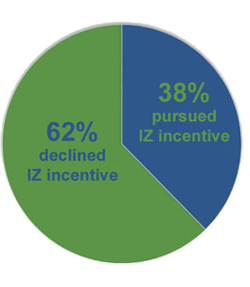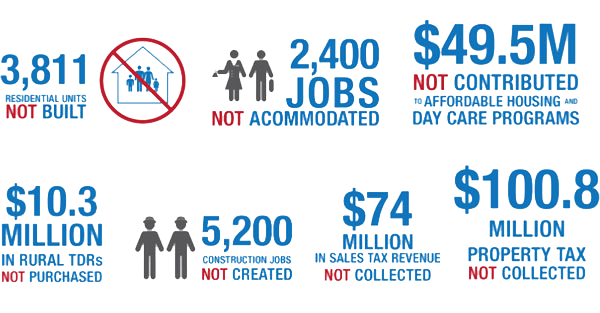Council Study Reveals The Inherent Futility Of Incentive Zoning
Seattle City Council asked for a reality check on Incentive Zoning (IZ) and now they have their smoking gun: Since the Program’s inception in 2001, 62% of eligible development projects declined to participate. That outcome demonstrates that the IZ Program is not only fundamentally broken, but also has resulted in the loss of significant public benefits, and hindered progress towards the City’s own sustainable development goals.
 It’s pretty simple: Most developers said “no thanks” to IZ because the incentive offered by additional development capacity was not sufficient to offset the additional risk and cost. And one component of that additional cost is the requirement to include subsidized affordable housing in the project, or to pay for its construction elsewhere, a.k.a. an in-lieu fee.
It’s pretty simple: Most developers said “no thanks” to IZ because the incentive offered by additional development capacity was not sufficient to offset the additional risk and cost. And one component of that additional cost is the requirement to include subsidized affordable housing in the project, or to pay for its construction elsewhere, a.k.a. an in-lieu fee.
Given the historic low participation rate in IZ under its existing encumbrances, it would seem obvious that increasing the requirements for affordable housing will only tip the scales further toward non-participation, in which case zero affordable housing is produced. When the toll is raised, the gains made from the projects that still opt in to the Program will be offset by the increasing portion of projects that decline. And this inherent “diminishing returns” aspect of IZ is why it should never be expected to have a consequential impact on Seattle’s affordable housing needs.
I wrote “would seem obvious” above because apparently it is not obvious to Seattle City Council, and all indications are that some Councilmembers will be seriously considering either raising the IZ in-lieu fees (again), or more likely eliminating the in-lieu fee option altogether and thereby requiring developers to subsidize the full cost of including affordable units in their projects.
In the South Lake Union neighborhood, Council recently imposed in-lieu fees that are up to 43% higher than the historic fees in downtown, and what is the result so far? Of 20 eligible development projects in the pipeline, 14 are not participating—a no thanks rate of 70%. South Lake Union could be considered a best case scenario for IZ, since it is one of the hottest real estate markets in the country. But even under ideal market conditions, for most projects the incentive was insufficient to overcome the encumbrance.
Based on the estimates of Council’s affordable housing consultant, mandating inclusion of affordable units in projects would be equivalent to jacking the in-lieu fees by a factor between about two and four.* It’s hard to conceive how this would not lead to a precipitous drop in IZ program participation. And again, that would result in even less affordable housing produced, along with underdevelopment in urban centers that runs counter both to Seattle’s Comprehensive Plan, and to the greater region’s goals for sustainable growth. Same goes for tweaking IZ to require affordability levels deeper than 80%AMI (i.e. where the real need lies)—the opportunity cost to developers will rise significantly due to the greater requisite subsidy, and the IZ participation rate will drop.
Since 2001, IZ in Seattle has generated about $27 million from in-lieu fees, which resulted in the production of about 600 affordable rental units, if the effect of leveraging funds from other sources is included. Council’s consultant predicts that because funding sources that have been leveraged in the past are drying up, from here on out the City should anticipate about a doubling of their expenses to produce affordable housing*—in other words only about 300 units could be produced from that $27 million. For reference, $27 million would cover the turn-key production costs of only about 110 typical multifamily units. To put those numbers in perspective, during that same time period, some 46,000 multifamily units were built in Seattle.
Some would argue that even though IZ produces a miniscule amount of affordable housing relative to the need, it’s still better than nothing. But this argument becomes indefensible when you consider the negative impacts of the underdevelopment that IZ can cause. The Downtown Seattle Association has published estimates of a wide range of public benefits that were forgone based on 25 projects in downtown and South Lake Union that opted to not participate in the IZ program, illustrated below:

City Council must be held accountable for putting this magnitude of public benefit at risk through the imposition of IZ. Granted, the added encumbrance of providing affordable housing is only one of many reasons developers might opt to forgo the maximum development capacity allowed through IZ. But those other factors will always be part of the development equation. And in any case, piling on affordable housing is guaranteed to tip the scale in the wrong direction, especially if the requirements are made more onerous, which is the direction the political winds are blowing.
The potential sacrifice of 3,811 new housing units is the most glaring illustration of how IZ is an intellectually bankrupt policy. The biggest driver of Seattle’s current housing affordability crunch is demand outstripping supply. When thousands of new housing units go unbuilt, that means thousands more households competing for existing housing, and at the end of the day, it will be the poorest households that get priced out. And it also means thousands more housing units likely to end up built in sprawling outlying areas.
To sum it up with bad cliches, Incentive Zoning is like trying to squeeze blood from a stone, and robbing Peter to pay Paul, and shooting yourself in the foot, all rolled into one. Given that in this case the stone is such a politically expedient scapegoat, there is no question that City Council’s life would be easier if the above cliches weren’t so apt. But the sooner Council accepts the inherent futility of IZ, the sooner they can get on with the hard work of developing better housing affordability strategies—that is, strategies that—unlike IZ—encourage market production of housing supply to help ease prices, have the potential to generate funds for subsidy commensurate with the need and cost, and place the tax burden on all property, not just new development.
>>>
*The Cornerstone Partnerhip’s estimates provided to City Council: Opportunity cost to developer of affordable units built in project = $100k – $200k/unit; In-lieu fee = $56k/unit; Historic cost to City = $44k/unit; Future cost to City = $95k/unit
>>>
Dan Bertolet is an urban planner at VIA Architecture and blogs at Citytank.

